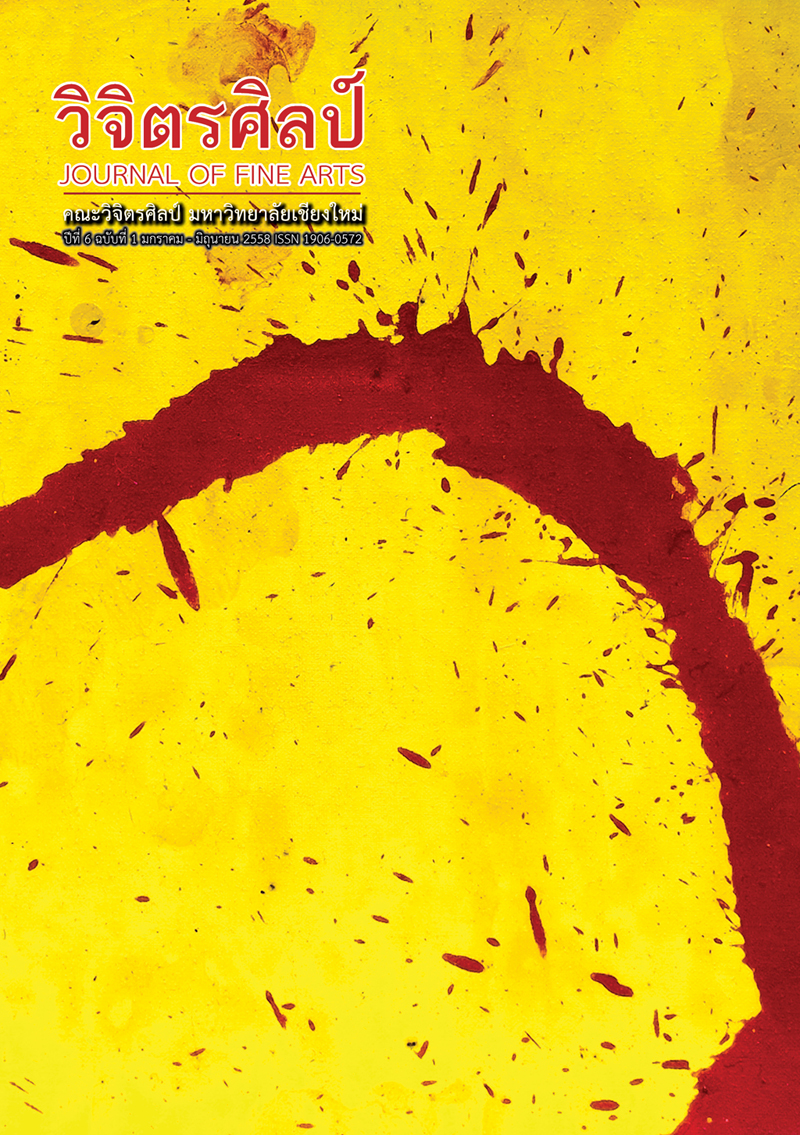ปูนปั้นวัดเกาะกลาง อำเภอป่าซาง จังหวัดลำพูน : การศึกษาเบื้องต้นด้านเทคนิค วัสดุ และความสัมพันธ์ที่มีต่อรูปแบบศิลปกรรม
Main Article Content
Abstract
บทความนี้มีวัตถุประสงค์เพื่อศึกษาเทคนิค และวัสดุในงานศิลปกรรมปูนปั้นล้านนาที่วัดเกาะกลาง ตำบลบ้านเรือน อำเภอป่าซาง จังหวัดลำพูนในเบื้องต้น ซึ่งเป็นงานปูนปั้นที่ได้จากการขุดค้นทางโบราณคดีระหว่าง พ.ศ. 2548 – 2549 โดยการวิจัยพรรณนาเชิงวิเคราะห์ (Analytical Description)
เทคนิคในงานปูนปั้นสามารถจำแนกออกเป็นสองกลุ่ม กลุ่มแรกเป็นงานประติมากรรมตัวภาพ อันได้แก่ เทวดา กินรี และภาพสัตว์ ซึ่งล้วนเป็นงานปูนปั้นนูนสูงที่มีการใช้อิฐเป็นแกนยึดติดกับผนังสถาปัตยกรรมทั้งสิ้น แล้วจึงปั้นปูนพอกเป็นรูปร่าง และเก็บรายละเอียด อันเป็นเทคนิคพื้นฐานที่พบสืบเนื่องมาโดยตลอดนับตั้งแต่ปูนปั้นในศิลปะหริภุญไชย
กลุ่มที่สองได้แก่ ปูนปั้นในกลุ่มลายพรรณพฤกษา ลายเมฆ และลายกนกที่มีการใช้โกลนลายหนุนตัวลาย ซึ่งทำให้ตัวลายมีความนูนเด่นจากผิวพื้น อันเป็นเทคนิคที่พบมากในศิลปะล้านนาในราวปลายพุทธศตวรรษที่ 20 – 21
การวิเคราะห์ปูนโดยวิธีการทางเคมีด้วยเทคนิคการเลี้ยวเบนรังสีเอ็กซ์แบบผง (Powder X-ray Diffractometer) และกล้องจุลทรรศน์อิเลคตรอนแบบส่องกราด (Scanning Electron Microscope: SEM) พบว่าองค์ประกอบหลัก คือ แคลเซียมคาร์บอเนต (Calcium Carbonate) ซิลิกอนออกไซด์ (Silicon Oxide) ซึ่งเป็นองค์ประกอบที่พบในปูน และทราย อันเป็นวัสดุหลักของปูนปั้น แต่ทุกตัวอย่างที่ทำการวิเคราะห์พบปริมาณของทรายมากกว่าปูนทั้งสิ้น นอกจากนั้น ยังพบร่องรอยการตกแต่งปูนปั้นด้วยชาดสีแดง
เทคนิคทางศิลปกรรมเช่นนั้น ทำให้เห็นถึงความสัมพันธ์ของงานปูนปั้นที่พบใหม่ ณ วัดเกาะกลางว่า มีเทคนิคที่สอดคล้องกับเทคนิคปูนปั้นที่พบมากในศิลปะล้านนาในราวปลายพุทธศตวรรษที่ 20 – 21 สอดคล้องกับรูปทรงเทวดา กินรี และกลุ่มลายพรรณพฤกษามีรูปแบบศิลปกรรมที่สัมพันธ์อย่างชัดเจนกับงานปูนปั้นล้านนาในราวปลายพุทธศตวรรษที่ 20 – 21 ฉะนั้น ปูนปั้นที่ขุดพบ ณ วัดเกาะกลางจึงควรมีอายุอยู่ในช่วงเวลาดังกล่าวเช่นกัน
ทั้งนี้ ยกเว้นปูนปั้นทางทิศตะวันออกเฉียงเหนือของวัดที่เรียกว่า “เนินแม่ม่าย” ซึ่งมีข้อสังเกตว่า น่าจะสร้างขึ้นในช่วงเวลาที่ต่างกัน อันเป็นประเด็นที่ควรจะศึกษาต่อไปในอนาคต
Stucco of Koh Klang Temple, Pasang District Lamphun : Primary study of techniques, materials and their relations to the style of art
This article has the objective of studying the techniques and materials used for creating Lanna style stuccos at Koh Klang Temple, Ban Ruen Sub-district, Pasang District, Lamphun Province. The stuccos studied here have been discovered from an archaeological excavation in the period of 2005 - 2006, and are described with the analytical description technique.
There are two techniques used for creating the studied stuccos. The first technique is reflected through the sculpture of some mythical characters such as angels, Kinnarees (half bird - half woman creatures) and animals. They are sculptures held with the walls of the construction by bricks which are used for forming a core of a sculpture before the plaster is applied on it in order to create the sculpture. This technique is a fundamental one continuously found since the sculptures in the Hariphunchai Period.
The second technique is used for creating floral, cloud and Thai motifs. These sculptures are stemmed up from the surface. It is widely found in Lanna arts from the end of 20th Buddhist century to 21st Buddhist century.
The analysis of the cement with Powder X-ray Diffractometer and Scanning Electron Microscope (SEM) leads to the findings that the main compositions of the cement are Calcium carbonate and Silicon oxide, which are generously found in cement and sand, which are the main materials of stuccos. However, from all the tested samples, the amount of sand is found to be greater than the amount of cement. Also, it is also discovered that the red colour from cinnabar is used for decorating the stuccos.
The aforementioned sculptural techniques reflect that the stuccos newly discovered at Koh Klang Temple are related to those widely found in Lanna arts from the end of 20th Buddhist century to 21st Buddhist century. The angels and Kinnarees sculptures and the floral motifs have the forms that are clearly related to the works from the end of 20th Buddhist century to 21st Buddhist century. Therefore, the stuccos discovered at Koh Klang Temple should be regarded to be created during the same period.
However, the stuccos, found in the northeastern side of the temple or the ‘Nern Mae Mai (Widow Slope)’, are the exceptions. They should have been created in a period different from the aforementioned one. These stuccos should be further studied.


